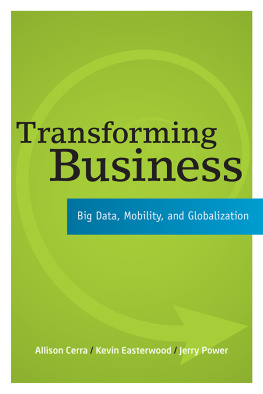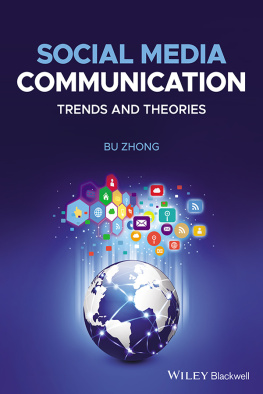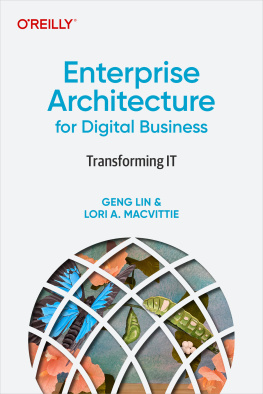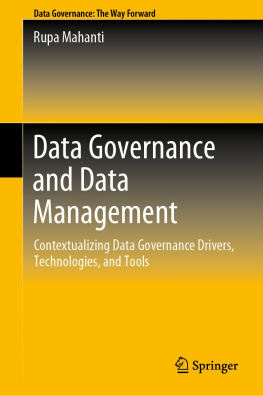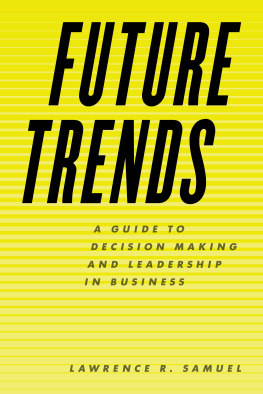Epilogue: The Next Decade
We always overestimate the change that will occur in the next two years and underestimate the change that will occur in the next ten. Dont let yourself be lulled into inaction.
Bill Gates
Although even the most astute forecasters would have likely underestimated the impact from the intersecting generational, technological, and enterprise forces that originated in the 1980s, todays enterprises can hopefully learn from the lessons of their counterparts, based on the primary and secondary evidence offered throughout this book. It would be foolhardy to consider what the next 30 years may reveal, but we the authors are prepared to make the following predictions as to how enterprises will continue to be reshaped over the next decade:
- Employee subsidization of IT costs will be common It is impossible for IT budgets or resources to increase commensurately with demand, as evidenced by the unending trajectory of data and mobile traffic in the enterprise. To attempt to meet the demand, enterprises will increasingly turn to innovative business models whereby employees help subsidize the costs for innovative enterprise services. These services have tangible value, and, according to the 2012 Alcatel-Lucent study, employees are willing to help pay for their deployment. Service providers with an interest in both consumer and enterprise markets will increasingly innovate to offer hybrid consumer/employee-based service plans that combine billing, offer discounts, or otherwise manage services across the dual personas between work and home.
- IT is too important to be left solely to IT As forward-leaning enterprises begin to recognize the cultural benefits enabled by the right IT ingredients, they will engage a much broader effort in approving and deploying technology in their companies. Particularly, Human Resources will have an increasingly louder voice at the technology table as further evidence is accumulated pertaining to technologys role in attracting and retaining employees. Far more creative career paths within the enterprise will emerge, with IT professionals being sourced from HR, Marketing, and other lines of business.
- The recruitment war will intensify, and intangible perks will be ammunition There is no question that enterprises face a dearth of qualified talent, whether in the IT function itself or among the rank-and-file business population capable of applying statistical muscle to business problems. These candidates will be in short supply. Although some companies are already responding with lucrative compensation packages and outrageous physical amenities within their corporate premises, others will fight the battle with the intangible perks that technology provides. Mainly, new candidates will increasingly be offered dynamic and flexible working arrangements to appeal to their mobile lifestyle. The current landscape involves new recruits having to earn such managerial trust over time, but the future will be a workplace where trust is assumed, until either employee or employer violates it.
- Machines will enter the workforce Just as the advent of the assembly line transformed the complexion of factory workers, machines with big data analytic capabilities will transform the knowledge worker of the twenty-first century. Employees will not suffer a deficit of data, although interpreting it into accurate and actionable prescriptions will separate corporate winners from losers. At the same time, machines will increasingly help employees engage with one another. Whereas todays social networks are those derived from a consumer curiosity to know who knows whom , semantic intelligence in the enterprise will connect employees by answering the more important question, who knows what. The result of machines either processing volumes of structured and unstructured data seamlessly to provide statistical results or simply directing employees to knowledge experts within their own companies will yield better and faster decision-making capabilities.
- IT will continue to be commoditized, although not underestimated as an ingredient toward sustainable competitive advantage Technology will continue to be commoditized, much as it has been for the past several decades. However, although IT by itself will fail to yield sustainable competitive advantage, it will neutralize barriers to entry, thereby allowing smaller firms to intensify the competitive landscape. And, as a key component of healthy cultures, ITs role in helping a company generate sustainable competitive advantage through a more functional cultural dynamic will earn the function greater esteem.
Even if only one of the above predictions becomes common practice in the next 10 years, the impact on enterprises will be significant. Those enterprises capable of riding the technological waves currently cresting will find themselves well positioned to compete and cooperate on a global stage. Those that resist the changes may find themselves holding fast to relics from the past, philosophies that are outdated and irrelevant in an enterprise increasingly without borders. In either case, the digital divide between enterprises will become clearer and will serve as yet one more predictive variable in determining the success of a company, industry, and nation.
Part 1
The Technology TrendsIn This Part
- Chapter 1 : The Mobile Movement
- Chapter 2 : The Cloud Conundrum
- Chapter 3 : The Data Deluge
- Chapter 4 : The Collaboration Craze
Chapter 1
The Mobile Movement
According to iPass, 92 percent of todays mobile workers believe their smartphones should be enabled for both work and personal use.
Merriam-Webster defines phobia as an exaggerated usually inexplicable and illogical fear of a particular object, class of objects, or situation. at a cost of more than $30 billion. Per consumer, that works out to about $250 each, and for the nomophobes among them, countless sleepless nights.
Although the negative impact of a personal mobile phone falling into the wrong hands can be high, the impact of losing a business-connected device can be devastating. To demonstrate the risk that a lost device can create for a business, the security firm Symantec conducted what it calls the Smartphone Honey Stick Project. This project involved the loss of 50 mobile phones across five U.S. cities. These phones were preloaded with a combination of well-labeled personal and corporate applications and data filessome of which featured a simulated login page with the username and password prepopulated. From an enterprise point of view, the results were sobering. The study found that when a lost business-connected mobile device is discovered, there is an 83 percent chance that the person who found it will attempt to access corporate data or the corporate network. A file titled HR Cases was accessed on 40 percent of the devices, and attempted access to a Remote Admin application was recorded on 49 percent of the devices. Of the 50 phones, there was an attempt to return only halfdespite the fact that the owners name and contact information were easily available.
The advent of mobile broadband networks has driven a pervasive, always-on connectivity and mentality. The rise of smartphones, tablets, and ultrabook computers gives employees the ability to leverage a constellation of applications and functionality to remain productive and get things done no matter where they are. The consumer market has wholeheartedly embraced this technology to manage both personal and family lives. Applications for personal finance, time management, information gathering, and even entertainment have become essential tools for a wide section of the population. The potential is even greater in the enterprise. Mobile technologies allow todays workforce the ability to work effectively from anywhere, to collaborate with others across geographies and time zones, and to realize productivity benefits by working smarter. However, the ultimate responsibility for the safety and integrity of company data and workflow lies with the companys Information Technology or Information Security Office. As the Smartphone Honey Stick Project so dramatically illustrates, the benefits of a mobile workplace are not without their risks. Despite the concerns and potential pitfalls, enterprises find themselves in the throes of one of the most significant workforce trends since the dawn of the personal computer, with an evolution as profound to match.

